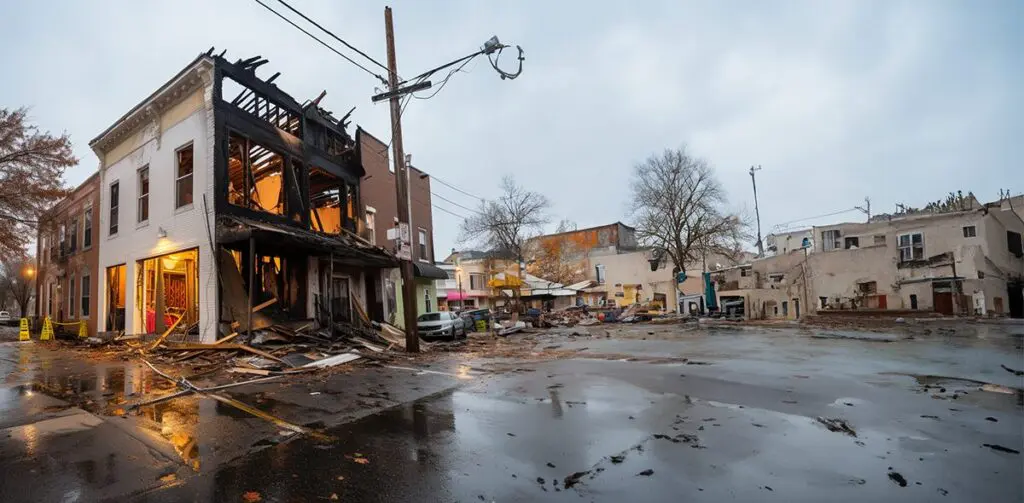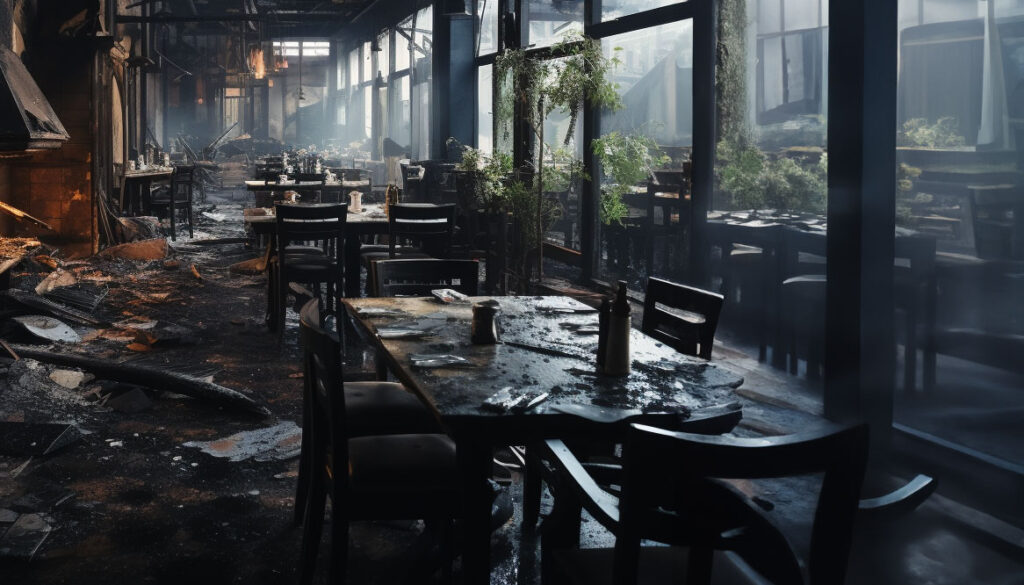Fill out the form below and we will get in touch with you ASAP or if you would rather call us for faster service please call 877-729-6365.
When a fire occurs at a restaurant, bar, or eating establishment, the general manager and owner are forced to take a primary role in navigating the restaurant fire damage insurance claim process and doing everything they can to ensure a smooth and expedient recovery process. Our public adjusters at Prime adjustments assist restaurant owners and managers through the complexities of managing a restaurant fire insurance claim.
Maintained by The Property Owner or Ownership Group
The master insurance policy is typically owned and maintained by the building owner, or sometimes an ownership group or trust, and responsible for the structure itself. This master policy covers common areas, structural elements, and liability for the entire building where the restaurant resides. While there are certain instances where the owner of the restaurant operating within the building owns the building itself, in most instances the restaurant leases the space, and carries their own commercial insurance policy.
Deductibles
Every insurance policy is different. They can be per occurrence deductible or an aggregate deductible. Prime Adjustments can review your policy and determine if the deductible applies per building or the total loss.
Covered Elements
This commercial policy typically covers the building’s structure, including the exterior walls, roof, common areas (hallways, lobbies, stairwells, bathrooms). It also includes liability coverage for accidents that occur in said common areas. This insurance policy may also provide coverage for a business interruption claim, if the building is rendered uninhabitable or unsuitable for tenants.
Responsibilities
The property owner is responsible for maintaining and renewing the structure’s insurance policy. They are also responsible for filing claims related to damage to common areas and structural elements.
Nearly all restaurants obtain insurance by buying a business owners policy (BOP), which combines together three coverages:
Owned by Individual Unit Tenants
If the restaurant operates within a larger building like an office tower, hotel, or retail center, the unit tenant is responsible for purchasing their own individual unit insurance policy. This policy covers the unit’s interior, business personal property, business interruption coverage, and provides liability coverage for incidents that occur within the business. Effectively this policy covers any damage that occurs from the exterior walls in.
Covered Elements
The individual unit policy covers the interior of the establishment, business personal property (including stock), and any improvements or additions made to the occupied space by the business owner. It also includes personal liability coverage for events that occur within the unit, such as kitchen fires or water damage originating from the unit.
Business Owner or Commercial Tenant Responsibilities
Business owners or tenants are responsible for purchasing and maintaining their own BOP policy. If a fire occurs within their unit, then their policy will cover their business personal property. Some common examples of business personal property claimed in a loss:
If the restaurant fire damage originates in a common area or another unit and causes damage to their unit and personal property, the tenant and building owner may need to coordinate with both their individual insurer and the master policy to ensure coverage in which their insurer may subrogate the claim.

Both the master policy and individual unit policies will be involved in the restaurant fire damage insurance claim process. Individual unit owners will need to file claims with their insurers for personal property, business interruption and liability coverage, while the building owner will handle claims related to common areas and structural damage.
Understanding the coverages between these policies and the responsibilities associated with each is critical for restaurant owners and managers as well as building owners who lease to restaurants to ensure proper coverage if a fire occurs. Prime Adjustments assists in sorting through the complexities of these insurance coverages when dealing with a fire damage insurance claim of this kind.

When navigating a fire damage insurance claim, at first you may feel the damages are minimal. There’s a fundamental interconnectedness of systems and a propensity for seemingly isolated damages to have more widespread consequences.
Electrical Systems:
Restaurant fires often originate due to faults in the electrical systems. Faulty wiring in one part of a building, can lead to a larger fire affecting multiple areas. The interconnected nature of electrical wiring can cause fire to spread through walls and ceilings.
HVAC Systems:
Heating, ventilation, and air conditioning systems can distribute smoke and heat throughout a building. Smoke damage can easily affect and damage other areas indirectly.
Hidden Damage:
Smoke and Soot: Even if the actual fire damage seems isolated, smoke and soot generated during a fire may travel through HVAC systems and hidden cavities. It can permeate walls, ceilings, and floors, causing hidden damage in seemingly unaffected areas. Prime Adjustments routinely retains industrial hygienists to better understand the full extent of these damages.
Water Damage:
Water used by the fire department to extinguish the fire can lead to secondary issues. Water may seep into walls and flooring, causing hidden structural damage and potential mold growth.
Fire Suppression Systems:
Sprinkler Systems: Sprinkler systems can disperse water throughout multiple areas, potentially causing water damage in addition to the fire damage.
Fire Doors and Compartmentation: Fire doors and fire-resistant partitions play a crucial role in preventing the spread of fire. If these systems fail, or if they are compromised during a fire, it can allow the fire to spread to seemingly isolated areas.
Building Materials:
Materials’ Fire Resistance: Depending on what materials were used on the initial build, these materials may have perpetuated the fire to spread. Some materials are more fire-resistant, while others can accelerate the fire’s growth. A minor restaurant fire can quickly spread if combustible materials are involved.
Smoke and Toxic Gases:
Airflow Patterns: The movement of smoke and toxic gases within a building is influenced by the building’s design and ventilation systems. These factors can cause seemingly isolated damages to have health consequences for occupants in other parts of the building.
When dealing with a fire insurance claim, it’s common for Prime Adjustments to involve different experts that multiple experts that have specific areas of expertise. The exact experts needed is based on the situation and complexity of the fire, the scope of damage, and the insurance policy coverage. Prime Adjustments coordinates these fire experts to ensure an accurate assessment of the damage to prove the claim damages.
Fire Investigators:
Fire investigators determine the cause and origin of a fire. With their expertise they examine fire scenes, collect evidence, and interview witnesses to establish whether the fire was accidental, intentional (arson), or caused by negligence. Fire Investigators are Certified Fire Investigators (CFIs) or Certified Fire and Explosion Investigators (CFEIs).
Forensic Fire Experts:
Forensic fire experts probe deeper into fire investigations, using scientific methods and analysis to reconstruct fire events, identify accelerants, and determine fire dynamics. Forensic fire experts often provide expert testimony in legal proceedings. Forensic fire experts may have certifications related to fire scene analysis and investigation.
Fire Safety Consultants:
Fire safety consultants assess buildings for compliance with fire codes and standards. Fire safety consultants contribute recommendations for fire prevention, detection, and suppression systems, helping building owners mitigate risks. Certified Fire Protection Specialists (CFPS) are common in this field.
Structural Engineers:
Structural engineers evaluate the integrity of the building and assess any damage that does adversely affect the livability, soundness, or structural integrity of the building, including the foundation, roof and load bearing walls. They provide expert opinions on whether the building can be repaired or needs to be condemned. Structural engineers hold a Professional Engineer (PE) License: Engineers should hold a PE license which is licensed by state.
Environmental Consultants:
Some fires result in hazardous materials or environmental damage, environmental consultants assess and address the environmental impact. Environmental consultants assess air and water quality and managing hazardous materials cleanup.
Industrial Hygienist:
An industrial hygienist is a trained professional who specializes in identifying and mitigating health and safety hazards in workplaces and industrial settings. Their primary goal is to protect the health and well-being of workers and the surrounding community by assessing and controlling various environmental factors and hazards.
Forensic Accountants:
Forensic accountants carefully review financial records, examine expenditures, and understand complex financial data to determine the extent of financial damage that will be sustained as a consequence of the loss. Forensic accountants are essential in proving the veracity of losses claimed, stopping fraud, and giving insurers in-depth information in the context of insurance claims. Their knowledge guarantees an accurate and impartial assessment of the financial impact, enabling a more efficient and transparent claims settlement procedure for both insurance companies and policyholders.
According to the National Cancer Institute, “soot is a byproduct of the incomplete burning of organic (carbon-containing) materials, such as wood, fuel oil, plastics, and household refuse. Soot can be seriously harmful. It’s a dark, powdery substance created when things like wood, fuel oil, and plastics don’t burn completely. This soot can contain cancer-causing stuff like arsenic, cadmium, and chromium. If you don’t clean up smoke and soot the right way, it can lead to really bad health problems like cancer. It can sneak into hidden parts of your restaurant, causing damage to things like insulation, electrical systems, and HVAC. The hidden smoke and soot aren’t just a health risk; they can also mess up your home’s electrical and mechanical equipment.
The complexity of fire damage extends beyond what meets the eye. It’s imperative to recognize the connection between interconnected systems, the potential for hidden damage, the importance of accurately verifying lost stock and business potential business interruption, as well as the legal and insurance implications when assessing and negotiating restaurant fire insurance claims. Prime Adjustments provides a thorough investigation and a comprehensive understanding of these factors that are crucial to accurately inventorying, scoping, and articulating the full extent of fire damage and its consequences to your carrier.
Beyond the immediate steps of contacting emergency service ensuring safety there are some important things to do to put yourself in the best position to get your restaurant restored as soon as possible.
Fill out the form below and we will get in touch with you ASAP or if you would rather call us for faster service please call 877-729-6365.
Smoke damage, though often less visible than its fiery counterpart, leaves a lasting damage imprint on properties that have endured the reach of smoke particles. This insidious aftermath coats surfaces with a film of residue, discolors fabrics, and infiltrates even the smallest crevices. Once it’s in your air ducts they must be cleaned or replaced. The distinct smoke odor, a reminder of the event, lingers in the air. Smoke damage restoration involves a meticulous process of cleaning, deodorizing, and restoring affected areas. From removing stubborn soot to employing advanced techniques that neutralize lingering odors, smoke damage experts meticulously rejuvenate spaces, ensuring a fresh start for both the physical environment and the peace of mind of property owners. These are issues you want to make sure are documented and accounted for in your fire damage insurance claim.